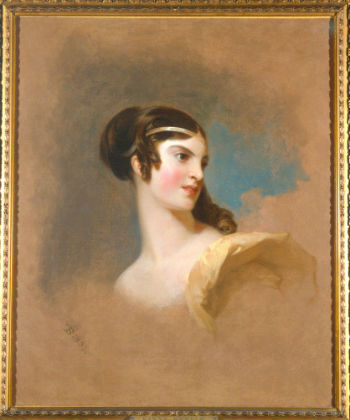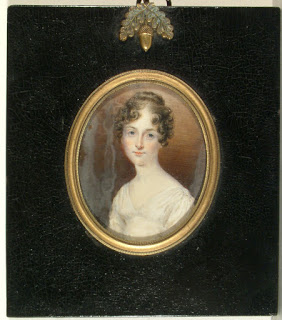
Fine Arts
The Rosenbach’s collection of paintings includes important American portraits by Gilbert Stuart, Thomas Sully, Bass Otis, Matthew Jouett, and John Wesley Jarvis; and European genre paintings including those attributed to Angelica Kauffman and the American expatriate Benjamin West. Many paintings are installed in the historic house where Rosenbach family portraits and travel souvenirs by artists of the school of Caneletto lend a personal quality to the collection.
Drawings range from the Italian Renaissance to the present, and from informal sketches to master drawings to preliminary drawings for book illustration. Artists include 18th-century French masters Fragonard, Le Prince, and Gravelot, as well as a rare portrait by Jacques Louis David; pencil drawings by William Blake and John Tenniel; and drawings from the Rosenbach’s Maurice Sendak holdings.
The collection of prints focuses on those associated with book illustration and shares many original artists with the Rosenbach’s drawings collection. Original artists represented by prints include Aubrey Beardsley, George Cruikshank, John Tenniel, and Charles Balthazer Julien Saint-Memin. Printmakers of note include the Dalziel Brothers, David Edwin, and William Blake. The Rosenbach also preserves nearly two hundred late-18th and 19th-century copper and steel printing plates used in printing both independent works and book illustrations, including designs by such noted artists as Thomas Sully and Titian Peale.
Sculpture in the collections dates from ancient Egypt and Cyprus to 20th-century Europe, with materials including bronze, stone, wood, and ceramic.
Collection Highlights
Portrait of an old man
Portrait of Joseph Gratz
Portrait of Maria Gratz by Thomas Sully
Portrait of Maria Gratz by Thomas Sully, dated 1831
Portrait of Rebecca Gratz
The Jabberwock
Related Posts
George Cruikshank, & Folk Horror at The Rosenbach
This blog post was written by Andrew White Folk horror! I think of old chestnuts like The Wicker Man, or new Ari Aster movies like Midsommar and Hereditary. But before folk horror was a genre of cinema it was a literary genre: folk horror thrives on Rosenbach library shelves in early Shakespeare printings of Macbeth and …
Matisse at The Rosenbach
Henri Émile Benoît Matisse was a leading figure in 20th-century art. Although he was primarily known as a painter, he also worked as a printmaker, draughtsman, and sculptor. Born in France, Matisse was passionate throughout his career about non-European art and design, and frequently incorporated aspects of Asian and African art and culture in his …
Violet Oakley and Edith Emerson: painters, partners, and paragons of art education
Of Two Minds: Creative Couples in Art & History showcases the creations of romantic couples who inspired, instructed, or even assisted one another in making art or knowledge. In anticipation of Women’s History Month beginning tomorrow, we shine the spotlight on two remarkable women who were artists, partners, and educators in an era when it was unusual for …
5 Questions with Amy Herman
A series of informal, intimate talks given by literary and cultural luminaries, In Conversation with the Rosenbach delves into fascinating histories, intellectual curiosities, and inspiring ideas. Each program offers the audience a chance to join the conversation after the talk and share their own thoughts and questions. Join us February 2 as art historian Amy …
Parisian Luxury
Although this 1824 print by George Cruikshank was doubtless intended as a dig at the stereotypically spoiled French dandy, I often find myself admiring the dandy’s set up, especially as we head into the craziness of the holiday season. The idea of relaxing in a brimming full hot bathtub while getting to enjoy a hot …
Ulysses Throughout the House
Today is the day after Bloomsday, but I wanted to squeeze in a Bloomsday blog post anyway. (Technically,since the day described in the book ends after midnight, maybe June 17 could be grandfathered in a little?) This year we extended our Bloomsday festival into the historic house: facsimiles of passages from the manuscript were spread …
Gravelot
This week’s blog post comes to us from collections intern Rebecca Schott. Hubert Francois Gravelot was a French illustrative artist during the early half of the 1700’s, and is credited with bringing the French Rococo style to English decorative art. Gravelot began his career by studying art in Paris and Rome but eventually settled on …
William Morris
We have posted before about William Morris’s Kelmscott Press, which strove to elevate the craft of hand-printing in the late 19th-century. but the Rosenbach also has an interesting example of Morris’s work in another arena: textile design. William Morris (1834-1896) wore many hats in his life: poet, novelist, artist, printer, manufacturer, political activist, and more. …
Marvelous Miniatures: Anna Claypoole Peale
Anna Claypoole Peale, born in 1791, came from an accomplished family of artists. Her uncle was the famous Charles Willson Peale and her father, James Peale, had been trained by his older brother and was an accomplished painter of miniatures and, later on, of still lives. (Unlike her cousins, Anna avoided the pressure of being …
















